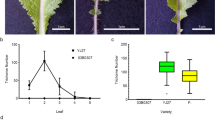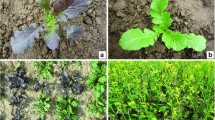Abstract
GLABRA1 (GL1) belongs to the group of R2R3-MYB transcription factors and is known to be essential for trichome initiation in Arabidopsis. In our previous study, we identified a GL1 ortholog in Brassica rapa as a candidate for the gene controlling leaf hairiness by QTL analysis and suggested that a 5-bp deletion (B-allele) and a 2-bp deletion (D-allele) in the exon 3 of BrGL1 and a non-synonymous SNP (C-allele) in the second nucleotide of exon 3 possibly cause leaf hairlessness. In this study, we transformed a B. rapa line having the B-allele with the A-allele (wild type) or the C-allele of BrGL1 under the control of the CaMV 35S promoter. The transgenic plants with the A-allele showed dense coverage of seedling tissues including stems, young leaves and hypocotyls with trichomes, whereas the phenotypes of those with the C-allele were unchanged. In order to obtain more information about allelic variation of GL1 in different plant lineages and its correlation with leaf hairiness, two GL1 homologs, i.e., RsGL1a and RsGL1b, in Raphanus sativus were analyzed. Allelic variation of RsGL1a between a hairless line and a hairy line was completely associated with hairiness in their BC1F1 population. Comparison of the full-length of RsGL1a in the hairless and hairy lines showed great variation of nucleotides in the 3′ end, which might be essential for its function and expression.







Similar content being viewed by others
References
Doyle JJ, Doyle JL (1990) Isolation of plant DNA from fresh tissue. Focus 12:13–15
Esau K (1977) Anatomy of seed plants, 2nd edn. Wiley, New York
Esch JJ, Chen M, Sanders M, Hillestad M, Ndkium S, Idelkope B, Neizer J, Marks MD (2003) A contradictory GLABRA3 allele helps define gene interactions controlling trichome development in Arabidopsis. Development 130:5885–5894
Gamborg OL, Miller RA, Ojima K (1968) Nutrient requirements of suspension cultures of soybean root cells. Exp Cell Res 50:151–158
Gazzani S, Gendall AR, Lister C, Dean C (2003) Analysis of the molecular basis of flowering time variation in Arabidopsis accessions. Plant Physiol 132:1107–1114
Grotewold E, Sainz MB, Tagliani L, Hernandez JM, Bowen B, Chandler VL (2000) Identification of the residues in the Myb domain of maize C1 that specify the interaction with the bHLH cofactor R. Proc Natl Acad Sci USA 97:13579–13584
Gruber MY, Wang S, Ethier S, Holowachuk J, Bonham-Smith PC, Soroka J, Lloyd A (2006) “HAIRY CANOLA”—Arabidopsis GL3 induces a dense covering of trichomes on Brassica napus seedlings. Plant Mol Biol 60:679–698
Hauser MT, Harr B, Schlotterer C (2001) Trichome distribution in Arabidopsis thaliana and its close relative Arabidopsis lyrata: molecular analysis of the candidate gene GLABROUS1. Mol Biol Evol 18:1754–1763
Hilscher J, Schlötterer C, Hauser M-T (2009) A single amino acid replacement in ETC2 shapes trichome patterning in natural Arabidopsis populations. Curr Biol 19:1747–1751
Hülskamp M (2004) Plant trichomes: a model for cell differentiation. Nat Rev 5:471–480
Ishida T, Hattori S, Sano R, Inoue K, Shirano Y, Hayashi H, Shibata D, Sato S, Kato T, Tabata S, Okada K, Wada T (2007) Arabidopsis TRANSPARENT TESTA GLABRA2 is directly regulated by R2R3 MYB transcription factors and is involved in regulation of GLABRA2 transcription in epidermal differentiation. Plant Cell 19:2531–2543
Johnson HB (1975) Plant pubescence: an ecological perspective. Bot Rev 41:233–258
Johnson CS, Kolevski B, Smyth DR (2002) TRANSPARENT TESTA GLABRA2, a trichome and seed coat development gene of Arabidopsis, encodes a WRKY transcription factor. Plant Cell 14:1359–1375
Kawagoe T, Shimizu KK, Kakutani T, Kudoh H (2011) Coexistence of trichome variation in a natural plant population: a combined study using ecological and candidate gene approaches. PLoS One 6:e22184
Kirik V, Simon M, Wester K, Schiefelbein J, Hülskamp M (2004) ENHANCER of TRY and CPC 2 (ETC2) reveals redundancy in the region-specific control of trichome development of Arabidopsis. Plant Mol Biol 55:389–398
Kivimäki M, Kärkkäinen K, Gaudeul M, Løe G, Ågren J (2007) Gene, phenotype and function: GLABROUS1 and resistance to herbivory in natural populations of Arabidopsis lyrata. Mol Ecol 16:453–462
Larkin JC, Oppenheimer DG, Pollock S, Marks MD (1993) Arabidopsis GLABROUS1 gene requires downstream sequences for function. Plant Cell 5:1739–1748
Li F, Kitashiba H, Inaba K, Nishio T (2009) A Brassica rapa linkage map of EST-based SNP markers for identification of candidate genes controlling flowering time and leaf morphological traits. DNA Res 16:311–323
Li F, Kitashiba H, Nishio T (2011) Association of sequence variation in Brassica GLABRA1 orthologs with leaf hairiness. Mol Breeding 28:577–584
Masucci JD, Rerie WG, Foreman DR, Zhang M, Galway ME, Marks MD, Schiefelbein JW (1996) The homeobox gene GLABRA2 is required for position-dependent cell differentiation in the root epidermis of Arabidopsis thaliana. Development 122:1253–1260
Mauricio R, Rausher MD (1997) Experimental manipulation of putative selective agents provides evidence for the role of natural enemies in the evolution of plant defense. Evolution 51:1435–1444
Murashige T, Skoog F (1962) A revised medium for rapid growth and bioassay with tobacco tissue culture. Physiol Plant 15:473–497
Oppenheimer DG, Herman PL, Sivakumaran S, Esch J, Marks MD (1991) A myb gene required for leaf trichome differentiation in Arabidopsis is expressed in stipules. Cell 67:483–493
Payne CT, Zhang F, Lloyd AM (2000) GL3 encodes a bHLH protein that regulates trichome development in arabidopsis through interaction with GL1 and TTG1. Genetics 156:1349–1362
Pesch M, Hülskamp M (2009) One, two, three models for trichome patterning in Arabidopsis? Curr Opin Plant Biol 12:587–592
Rerie WG, Feldmann KA, Marks MD (1994) The GLABRA2 gene encodes a homeo domain protein required for normal trichome development in Arabidopsis. Genes Dev 8:1388–1399
Schellmann S, Schnittger A, Kirik V, Wada T, Okada K, Beermann A, Thumfahrt J, Jurgens G, Hülskamp M (2002) TRIPTYCHON and CAPRICE mediate lateral inhibition during trichome and root hair patterning in Arabidopsis. EMBO J 21:5036–5046
Shiokai S, Shirasawa K, Sato Y, Nishio T (2010) Improvement of the dot-blot-SNP technique for efficient and cost-effective genotyping. Mol Breeding 25:179–185
Siebert PD, Chenchik A, Kellogg DE, Lukyanov KA, Lukyanov SA (1995) An improved PCR method for walking in uncloned genomic DNA. Nucleic Acids Res 23:1087–1088
Symonds VV, Godoy AV, Alconada T, Botto JF, Juenger TE, Casal JJ, Lloyd AM (2005) Mapping quantitative trait loci in multiple populations of Arabidopsis thaliana identifies natural allelic variation for trichome density. Genetics 169:1649–1658
Szymanski DB, Lloyd AM, Marks MD (2000) Progress in the molecular genetic analysis of trichome initiation and morphogenesis in Arabidopsis. Trends Plant Sci 5:214–219
Takasaki T, Hatakeyama K, Ojima K, Watanabe M, Toriyama K, Hinata K (1997) Factors influencing Agrobacterium-mediated transformation of Brassica rapa L. Breed Sci 47:127–134
Uphof JCT (1962) Plant hairs. In: Zimmermann W, Ozenda PG (eds) Encyclopedia of plant anatomy, vol 5(4). Gebruder Borntraeger, Berlin, pp 1–206
Wada T, Tachibana T, Shimura Y, Okada K (1997) Epidermal cell differentiation in Arabidopsis determined by a Myb homolog, CPC. Science 277:1113–1116
Walker AR, Davison PA, Bolognesi-Winfield AC, James CM, Srinivasan N, Blundell TL, Esch JJ, Marks MD, Gray JC (1999) The TRANSPARENT TESTA GLABRA1 locus, which regulates trichome differentiation and anthocyanin biosynthesis in Arabidopsis, encodes a WD40 repeat protein. Plant Cell 11:1337–1350
Wang S, Chen JG (2008) Arabidopsis transient expression analysis reveals that activation of GLABRA2 may require concurrent binding of GLABRA1 and GLABRA3 to the promoter of GLABRA2. Plant Cell Physiol 49:1792–1804
Wang N, Qian W, Suppanz I, Wei L, Mao B, Long Y, Meng J, Müller AE, Jung C (2011) Flowering time variation in oilseed rape (Brassica napus L.) is associated with allelic variation in the FRIGIDA homologue BnaA.FRI.a. J Exp Bot 62:5641–5658
Yuan YX, Wu J, Sun RF, Zhang XW, Xu DH, Bonnema G, Wang XW (2009) A naturally occurring splicing site mutation in the Brassica rapa FLC1 gene is associated with variation in flowering time. J Exp Bot 60:1299–1308
Zhang F, Gonzalez A, Zhao M, Payne CT, Lloyd A (2003) A network of redundant bHLH proteins functions in all TTG1-dependent pathways of Arabidopsis. Development 130:4859–4869
Zhao M, Morohashi K, Hatlestad G, Grotewold E, Lloyd A (2008) The TTG1-bHLH-MYB complex controls trichome cell fate and patterning through direct targeting of regulatory loci. Development 135:1991–1999
Acknowledgments
We are grateful to Dr. Ishida of NARO Institute of Vegetable and Tea Science and Dr. Sakamoto of Takii Seed Co. Ltd. for providing plant materials of R. sativus. This work was supported in part by the Program for Promotion of Basic and Applied Researches for Innovations in Bio-oriented Industry (BRAIN).
Author information
Authors and Affiliations
Corresponding author
Additional information
Communicated by M. Havey.
Electronic supplementary material
Below is the link to the electronic supplementary material.
Rights and permissions
About this article
Cite this article
Li, F., Zou, Z., Yong, HY. et al. Nucleotide sequence variation of GLABRA1 contributing to phenotypic variation of leaf hairiness in Brassicaceae vegetables. Theor Appl Genet 126, 1227–1236 (2013). https://doi.org/10.1007/s00122-013-2049-1
Received:
Accepted:
Published:
Issue Date:
DOI: https://doi.org/10.1007/s00122-013-2049-1




